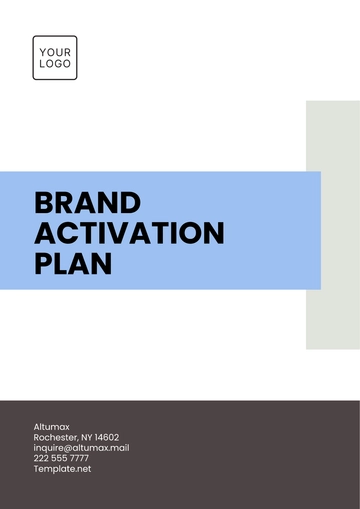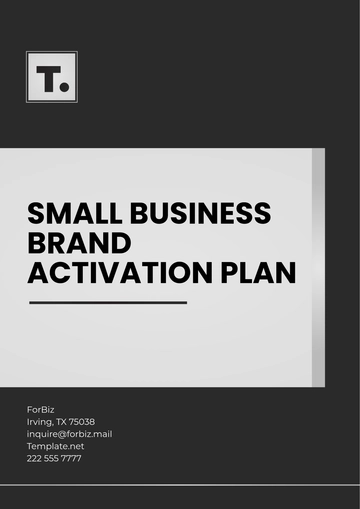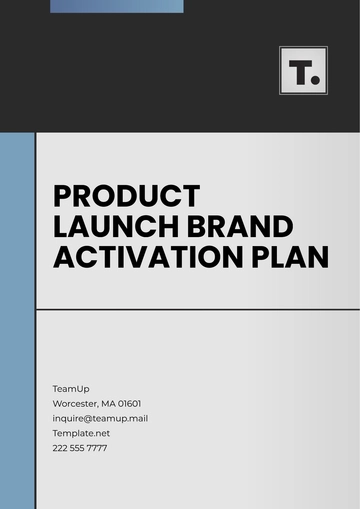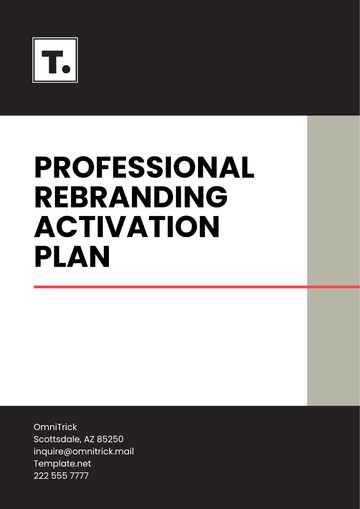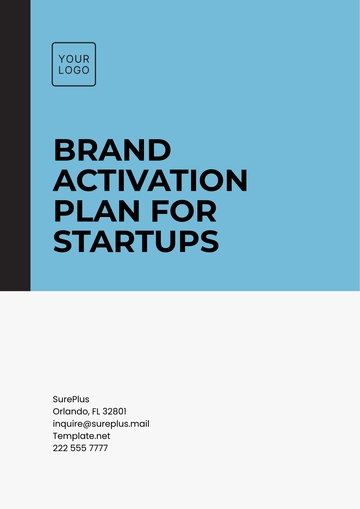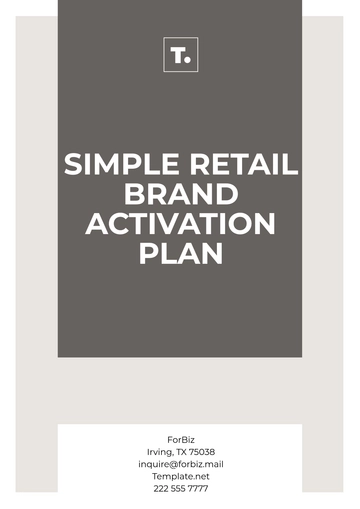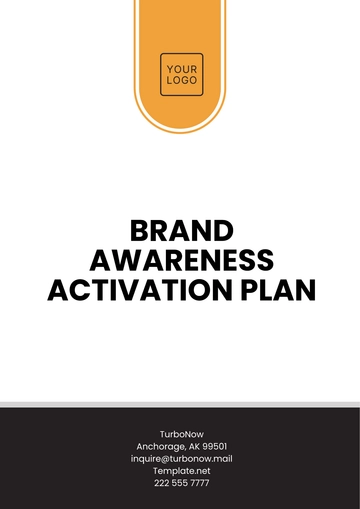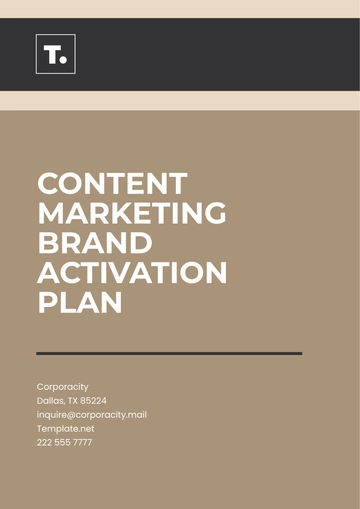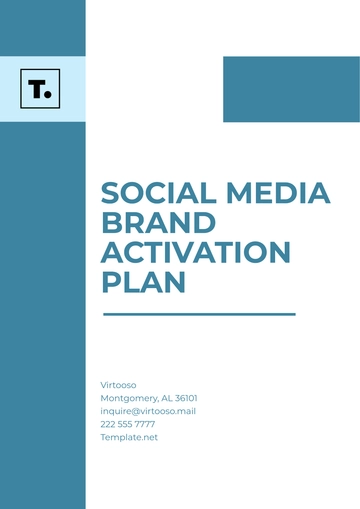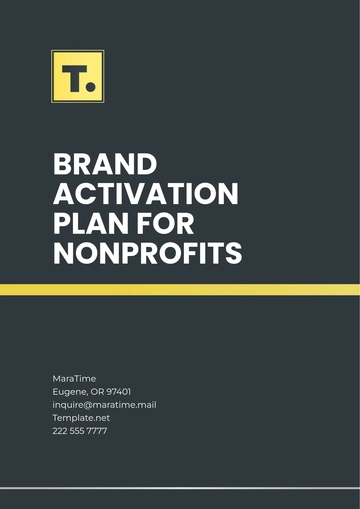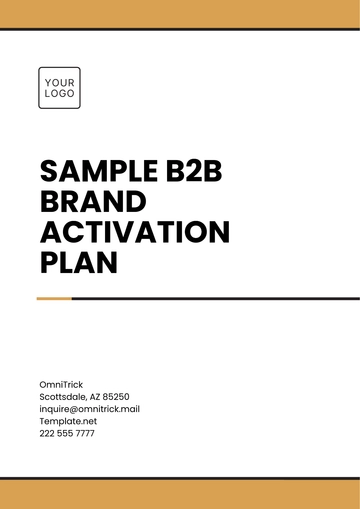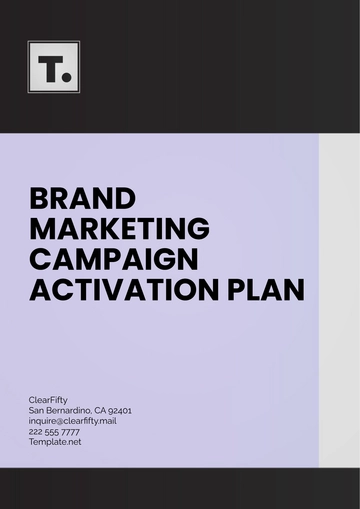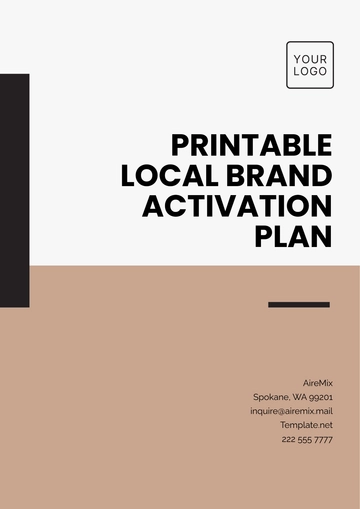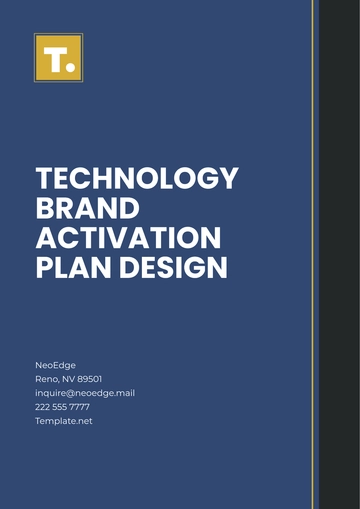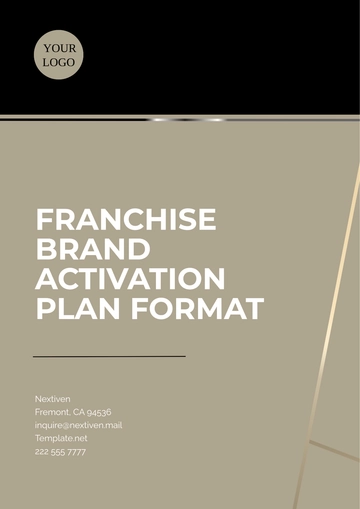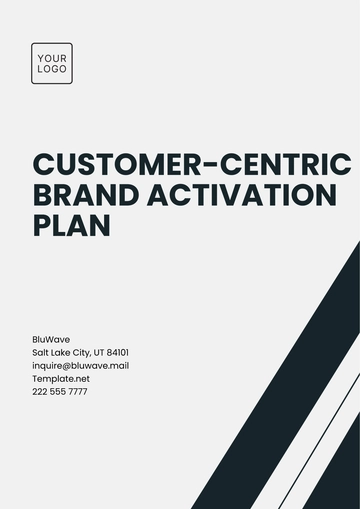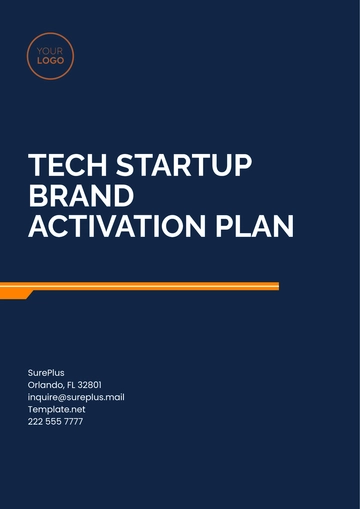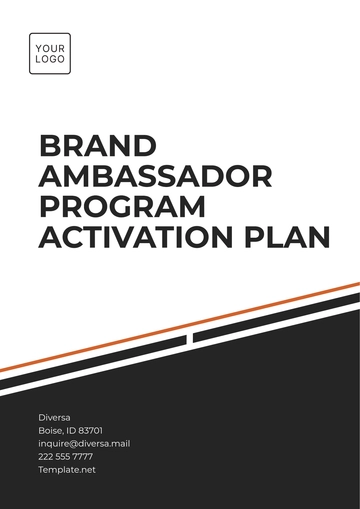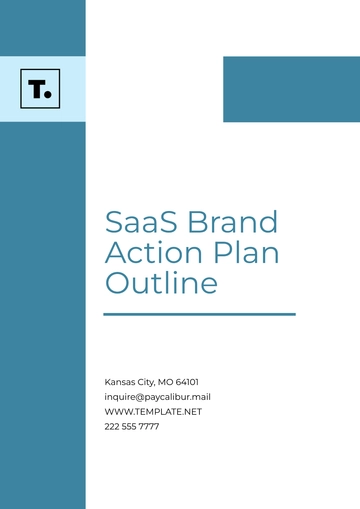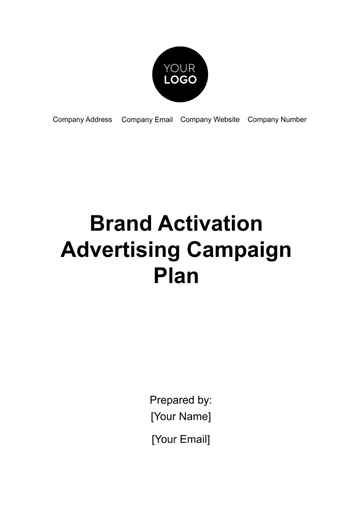Free Brand Activation Advertising Campaign Plan
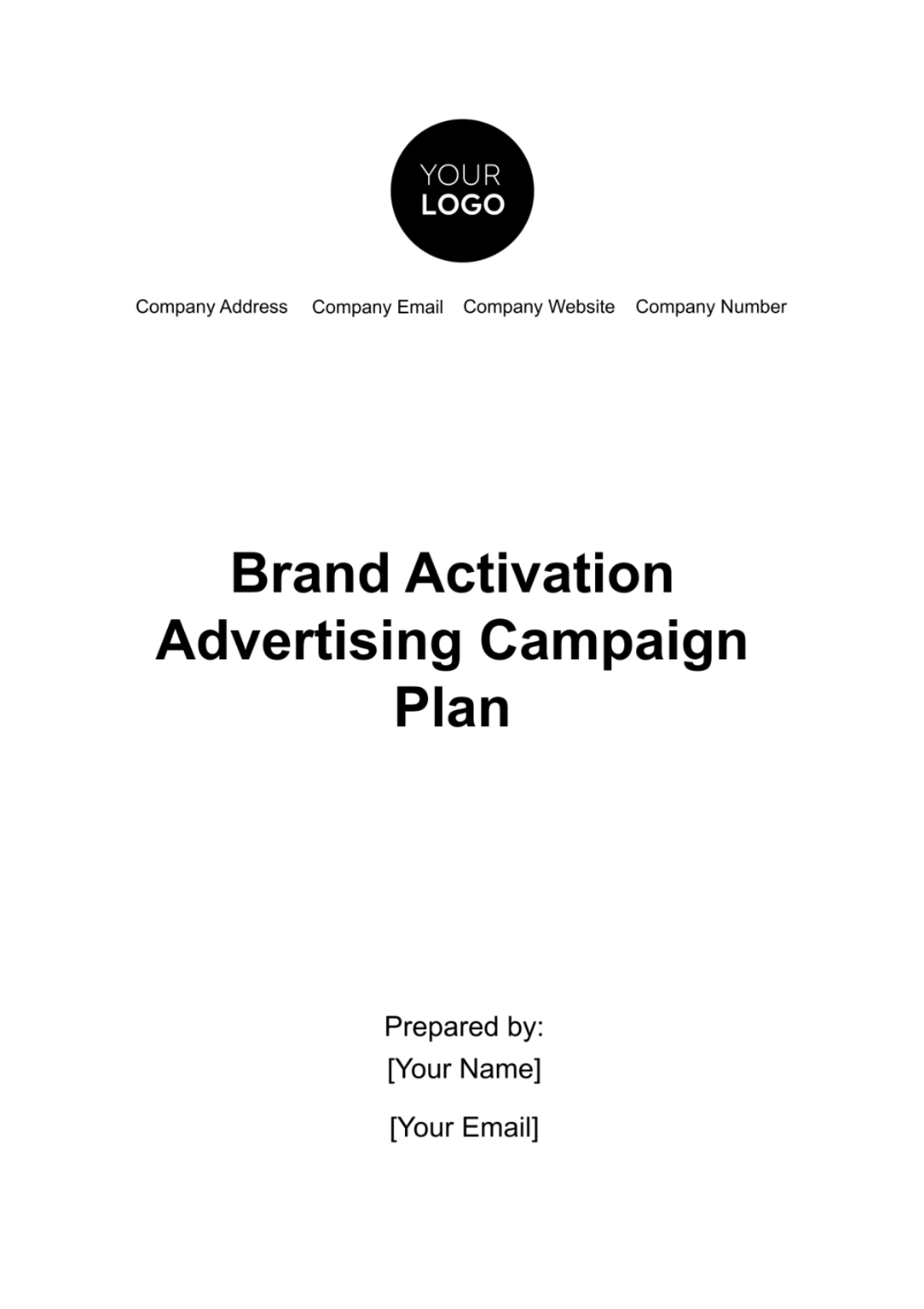
1. Executive Summary
This Brand Activation Advertising Campaign Plan for [Your Company Name] is meticulously crafted to strategically introduce and establish our brand in the competitive marketplace. Spanning over [Specify Duration], this campaign aims to not only reach a broad audience but also to forge a meaningful and enduring connection with them. At its core, the plan is structured to resonate with our target demographics through tailored messaging and innovative engagement tactics.
Central to this campaign is our commitment to blending creativity with data-driven strategies. We have conducted an in-depth analysis of our target audience, comprising their demographics, behavior patterns, and psychographics, to ensure that our campaign resonates on a personal level. This insight informs our multi-faceted approach which encompasses digital, print, social media, and out-of-home advertising strategies.
Our digital strategy leverages the latest trends in online marketing, including targeted advertisements and content marketing, to maximize reach and engagement. For print and out-of-home advertising, we have identified high-traffic urban areas and shopping centers as prime locations for our visually striking and message-driven materials. Our social media strategy is designed to amplify our brand presence, with a focus on regular, engaging posts and interactive campaigns.
A substantial part of this plan is dedicated to the creative concepts that will define our campaign's look and feel. Themed "Innovate with [Your Company Name]," these concepts are designed to be visually impactful and align with our brand's ethos.
The budget allocation and resource planning are carefully laid out to ensure an efficient and effective utilization of funds, detailed in a comprehensive financial plan. Additionally, we have included a robust risk management strategy to proactively address potential challenges.
In essence, this document is not just a campaign plan; it is a strategic blueprint for making [Your Company Name] a recognized and trusted brand in the hearts and minds of our audience.
2. Campaign Objectives
The "Campaign Objectives" section is a cornerstone of the Brand Activation Advertising Campaign Plan for [Your Company Name]. It outlines the primary goals we aim to achieve through this campaign. These objectives are not only ambitious but also measurable, ensuring we can track our progress and make adjustments as needed. They serve as guiding beacons for all our campaign strategies and creative decisions.
Increase Brand Awareness. Our foremost objective is to increase brand awareness. This means making [Your Company Name] more recognizable and familiar to our target audience. We plan to achieve this through a combination of strategic advertising placements, memorable branding elements, and consistent messaging across all platforms. The aim is to create a significant presence in the market, so that when consumers think of our industry or product category, [Your Company Name] is one of the first names that come to mind.
Boost Customer Engagement. Enhancing customer engagement is pivotal to the success of our campaign. We seek to not just reach our audience but to actively engage them in meaningful ways. This includes creating interactive and engaging content, encouraging feedback, and fostering a community around our brand. By building a strong relationship with our audience, we aim to turn casual observers into loyal customers and brand advocates.
Drive Traffic to [Your Company Website]. A key measurable goal of our campaign is to drive increased traffic to [Your Company Website]. This objective is crucial for converting audience interest into tangible actions, such as product inquiries, newsletter sign-ups, or online sales. We plan to use targeted digital advertising, SEO strategies, and compelling content to attract visitors to our website, where they can learn more about our products and services.
Expand Social Media Presence. Finally, expanding our social media presence is essential in today’s digitally connected world. Our goal is to increase our follower base, boost engagement rates, and enhance our overall brand visibility on platforms like [Your Social Media]. Social media is not just a tool for broadcasting our message; it's a powerful platform for two-way communication, community building, and brand personalization. By growing our social media presence, we aim to create a digital ecosystem where our brand can thrive and connect with our audience on a more personal level.
Each of these objectives plays a crucial role in the overall success of the Brand Activation Advertising Campaign. They are interlinked, with the achievement of one feeding into the success of the others, ultimately leading to a strong, engaged, and growing customer base for [Your Company Name].
3. Target Audience Analysis
This analysis serves as the foundation for our entire campaign, ensuring that every strategy and creative decision is informed by a deep understanding of who we are trying to reach. It involves a comprehensive examination of our target audience's demographics, behavior patterns, and psychographics. By gaining a clear picture of our audience, we can tailor our campaign to resonate more effectively with them, thereby increasing the likelihood of achieving our campaign objectives.
A thorough understanding of the target audience is crucial because it determines not just what we say in our campaign, but how and where we say it. It influences the choice of advertising channels, the tone of the messaging, and even the design of the creative elements.
Below is a table summarizing the key aspects of our target audience analysis:
Aspect | Description | Sample Content Details |
Demographics | Age, Location, Interests | Age Range: 25-45 years, Urban and Suburban locations, Interests in [Specify Industry or Lifestyle Segment] |
Behavior Patterns | Online Shopping Habits, Media Consumption | High frequency of online purchases, predominantly consumes digital media including social platforms and streaming services |
Psychographics | Lifestyle, Values | Lifestyle: Active and Tech-savvy, Values: Sustainability, Innovation, and Community Engagement |
This detailed analysis provides a framework for all our campaign efforts. Understanding the age range and geographic locations of our target audience helps in selecting the right media and timing for our advertisements. Knowing their online shopping habits and media consumption patterns informs our digital marketing strategies. And understanding their lifestyle and values helps in crafting messages that resonate on a deeper, more personal level.
By targeting our campaign precisely and relevantly to our audience's preferences and behaviors, we increase our chances of engaging them effectively. This chapter is not just about identifying our audience; it's about understanding them so thoroughly that our brand becomes a natural part of their lives.
4. Campaign Strategy
The "Campaign Strategy" chapter is a pivotal part of the Brand Activation Advertising Campaign Plan for [Your Company Name], delineating the specific tactics we will employ across various advertising channels. This multi-pronged strategy is designed to ensure that our brand message is delivered effectively to our target audience, leveraging the strengths of each channel for maximum impact.
Our campaign strategy is divided into three main areas: Digital Strategy, Print and Out-of-Home Strategy, and Social Media Strategy. Each of these strategies is tailored to the unique characteristics of the respective channels and the preferences of our target audience.
Here is a detailed table outlining our approach for each strategy:
Strategy Component | Element | Details | Additional Content Samples |
Digital Strategy | Channels | Google Ads, SEO, Email Marketing | Utilizing Google Ads for targeted visibility, improving search rankings through SEO, and engaging customers directly via Email Marketing |
Focus | Targeted Advertisements, Content Marketing | Creating customized ads for specific audience segments; developing informative and engaging content to build brand authority | |
Print and Out-of-Home Strategy | Materials | Brochures, Billboards | Designing eye-catching brochures for distribution; creating impactful billboards for high-traffic locations |
Locations | Urban Areas, Shopping Centers | Placing advertisements in urban hotspots and busy shopping centers to maximize exposure | |
Social Media Strategy | Platforms | [Your Social Media] | Active engagement on platforms like Facebook, Instagram, Twitter, leveraging each platform's unique features |
Content | Regular Posts, Interactive Campaigns | Posting regular updates, behind-the-scenes content, and running interactive campaigns to boost engagement |
Each element of our campaign strategy has been carefully considered to align with our overall objectives and the preferences of our target audience. The digital strategy focuses on online platforms to capture the attention of our tech-savvy audience. The print and out-of-home strategy leverages traditional media's physical presence to create a tangible brand experience. And the social media strategy is centered around building a community and engaging directly with customers.
By integrating these strategies, [Your Company Name] aims to create a cohesive and impactful advertising campaign that resonates across all channels. This approach not only ensures broad reach and visibility but also fosters deeper connections with our audience, driving engagement and brand loyalty.
5. Creative Concepts
This chapter is a pivotal part of the Brand Activation Advertising Campaign Plan for [Your Company Name], delineating the specific tactics we will employ across various advertising channels. This multi-pronged strategy is designed to ensure that our brand message is delivered effectively to our target audience, leveraging the strengths of each channel for maximum impact.
Our campaign strategy is divided into three main areas: Digital Strategy, Print and Out-of-Home Strategy, and Social Media Strategy. Each of these strategies is tailored to the unique characteristics of the respective channels and the preferences of our target audience.
Here is a detailed table outlining our approach for each strategy:
Strategy Component | Element | Details | Additional Content Samples |
Digital Strategy | Channels | Google Ads, SEO, Email Marketing | Utilizing Google Ads for targeted visibility, improving search rankings through SEO, and engaging customers directly via Email Marketing |
Focus | Targeted Advertisements, Content Marketing | Creating customized ads for specific audience segments; developing informative and engaging content to build brand authority | |
Print and Out-of-Home Strategy | Materials | Brochures, Billboards | Designing eye-catching brochures for distribution; creating impactful billboards for high-traffic locations |
Locations | Urban Areas, Shopping Centers | Placing advertisements in urban hotspots and busy shopping centers to maximize exposure | |
Social Media Strategy | Platforms | [Your Social Media] | Active engagement on platforms like Facebook, Instagram, Twitter, leveraging each platform's unique features |
Content | Regular Posts, Interactive Campaigns | Posting regular updates, behind-the-scenes content, and running interactive campaigns to boost engagement |
Each element of our campaign strategy has been carefully considered to align with our overall objectives and the preferences of our target audience. The digital strategy focuses on online platforms to capture the attention of our tech-savvy audience. The print and out-of-home strategy leverages traditional media's physical presence to create a tangible brand experience. And the social media strategy is centered around building a community and engaging directly with customers.
By integrating these strategies, [Your Company Name] aims to create a cohesive and impactful advertising campaign that resonates across all channels. This approach not only ensures broad reach and visibility but also fosters deeper connections with our audience, driving engagement and brand loyalty.
6. Budget and Resources
The chapter outlines a comprehensive financial blueprint for the campaign, detailing the estimated costs and specifying the allocation of resources across different marketing channels. This chapter is essential for ensuring that the campaign is financially feasible, and the resources are effectively utilized to achieve maximum impact.
A well-planned budget is key to the success of any advertising campaign. It ensures that every dollar spent contributes towards meeting the campaign objectives. By allocating specific budgets to different components of the campaign, we can maintain financial discipline while ensuring that each element is adequately funded to perform optimally.
In addition to financial planning, this chapter also addresses the allocation of human and material resources. It specifies which tasks will be handled in-house, which will require external expertise, and the tools and services needed for each segment of the campaign. This holistic view of both financial and resource planning is crucial for a smooth campaign execution and achieving the desired outcomes.
Item | Estimated Cost | Resource Allocation |
Digital Marketing | $40,000 | In-house team, SEO tools |
Print Material | $20,000 | Design Agency, Printing Services |
Social Media | $30,000 | Social Media Manager, Ad Budget |
Total | $90,000 | - |
Through careful budgeting and resource allocation, we aim to not only optimize our spending but also to leverage our assets in the most efficient way possible, ensuring a high return on investment for [Your Company Name].
7. Execution Timeline
It's essential to have a clear and well-defined timeline to ensure that each element of the campaign is executed in a timely and coordinated manner. This timeline serves as a roadmap, guiding the team through the campaign's lifecycle from launch to conclusion.
A meticulously planned timeline helps in managing the campaign efficiently, allowing for timely adjustments based on performance metrics and feedback. It ensures that all team members are aligned on key dates and milestones, facilitating better coordination and smoother workflow.
The table below outlines the key dates and milestones of our campaign, providing a clear overview of its progression:
Milestone | Date | Additional Details |
Campaign Launch | [Month Day, Year] | Official start of the campaign; all marketing channels go live. |
Mid-Campaign Review | [Month Day, Year] | Assessment of campaign performance halfway through; opportunity for adjustments and optimization. |
Campaign Conclusion | [Month Day, Year] | End of the campaign; final push and wrap-up of all marketing activities. |
This timeline not only marks the beginning and end of the campaign but also includes a critical mid-campaign review. This review is an opportunity to analyze the campaign's progress against its objectives, making any necessary adjustments to ensure its success. By adhering to this timeline, [Your Company Name] aims to execute a well-organized and effective advertising campaign that achieves its set goals within the stipulated time frame.
8. Key Performance Indicators (KPIs)
The "Key Performance Indicators (KPIs)" chapter is a vital component of the Brand Activation Advertising Campaign Plan for [Your Company Name]. It outlines the specific metrics by which the success of the campaign will be measured. KPIs are essential as they provide quantifiable targets that the campaign aims to achieve, allowing us to evaluate its effectiveness and make data-driven decisions.
Setting clear and measurable KPIs is crucial for monitoring the campaign's progress and assessing its impact. These indicators help in aligning the campaign activities with the overall business objectives of [Your Company Name] and provide a basis for continuous improvement.
Below is a table summarizing the primary KPIs for our campaign, along with their respective targets:
KPI | Target | Description |
Website Traffic Increase | 40% | Aiming for a 40% increase in the number of visitors to [Your Company Website] compared to pre-campaign levels. This reflects the effectiveness of our digital marketing strategies in attracting new and returning visitors. |
Social Media Followers | Gain 30,000 | Targeting an increase of 30,000 followers across our social media platforms, indicating enhanced brand visibility and appeal on social media. |
Customer Engagement Rate | Increase by 50% | Striving for a 50% increase in customer engagement rates, which includes metrics like comments, likes, shares, and responses to social media posts and digital content. This measures how effectively we are engaging our audience and creating interactive experiences. |
These KPIs will be closely monitored throughout the campaign. Regular analysis of these metrics will provide insights into the performance of different aspects of the campaign, enabling us to make informed decisions and optimize strategies as needed. Achieving these KPIs will signify the successful delivery of the campaign objectives and the strengthening of [Your Company Name]'s presence in the market.
9. Risk Management
This chapter is dedicated to identifying potential risks that could impact the campaign and outlining strategies to mitigate them. Effective risk management is crucial for ensuring the smooth execution of the campaign and for safeguarding against factors that could hinder its success.
This chapter is not just about foreseeing potential challenges but also about preparing proactive solutions and contingency plans. By anticipating and planning for these risks, [Your Company Name] can ensure that the campaign remains on track even in the face of unforeseen events.
Below is a table that outlines key risks identified for the campaign, along with mitigation strategies:
Risk Factor | Description | Mitigation Strategy |
Market Changes | Unexpected shifts in market trends or consumer behavior that could affect the campaign’s relevance or effectiveness. | Regular market analysis and flexibility in campaign strategy to adapt to new trends and consumer preferences. |
Budget Overruns | The risk of the campaign exceeding its allocated budget, leading to financial strain. | Rigorous budget monitoring and having a contingency fund set aside for unexpected expenses. |
Technology Failures | Potential technical issues with digital marketing tools, website crashes, or social media glitches. | Implementing robust IT support and backup systems, and having alternative platforms or strategies ready for deployment. |
By systematically addressing these risk factors, [Your Company Name] aims to minimize their potential impact on the campaign. This proactive approach to risk management is essential for maintaining the integrity of the campaign and ensuring that it meets its objectives without significant disruptions.
10. Appendix and References (Attached)
Appendix A: Creative Mockups
Appendix B: Detailed Budget Breakdown
References: Market Research, Case Studies
Contact Information:
Name: [Your Name]
Email: [Your Personal Email]
Phone: [Your User Phone]
This document is confidential and intended for the use of [Your Company Name] only.
- 100% Customizable, free editor
- Access 1 Million+ Templates, photo’s & graphics
- Download or share as a template
- Click and replace photos, graphics, text, backgrounds
- Resize, crop, AI write & more
- Access advanced editor
Introducing the Brand Activation Advertising Campaign Plan Template from Template.net! Crafted for marketers seeking efficiency and impact, this editable and customizable template streamlines campaign planning. With our intuitive Ai Editor Tool, strategize seamlessly and captivate your audience. Elevate your brand activation game effortlessly with this essential resource.
You may also like
- Finance Plan
- Construction Plan
- Sales Plan
- Development Plan
- Career Plan
- Budget Plan
- HR Plan
- Education Plan
- Transition Plan
- Work Plan
- Training Plan
- Communication Plan
- Operation Plan
- Health And Safety Plan
- Strategy Plan
- Professional Development Plan
- Advertising Plan
- Risk Management Plan
- Restaurant Plan
- School Plan
- Nursing Home Patient Care Plan
- Nursing Care Plan
- Plan Event
- Startup Plan
- Social Media Plan
- Staffing Plan
- Annual Plan
- Content Plan
- Payment Plan
- Implementation Plan
- Hotel Plan
- Workout Plan
- Accounting Plan
- Campaign Plan
- Essay Plan
- 30 60 90 Day Plan
- Research Plan
- Recruitment Plan
- 90 Day Plan
- Quarterly Plan
- Emergency Plan
- 5 Year Plan
- Gym Plan
- Personal Plan
- IT and Software Plan
- Treatment Plan
- Real Estate Plan
- Law Firm Plan
- Healthcare Plan
- Improvement Plan
- Media Plan
- 5 Year Business Plan
- Learning Plan
- Marketing Campaign Plan
- Travel Agency Plan
- Cleaning Services Plan
- Interior Design Plan
- Performance Plan
- PR Plan
- Birth Plan
- Life Plan
- SEO Plan
- Disaster Recovery Plan
- Continuity Plan
- Launch Plan
- Legal Plan
- Behavior Plan
- Performance Improvement Plan
- Salon Plan
- Security Plan
- Security Management Plan
- Employee Development Plan
- Quality Plan
- Service Improvement Plan
- Growth Plan
- Incident Response Plan
- Basketball Plan
- Emergency Action Plan
- Product Launch Plan
- Spa Plan
- Employee Training Plan
- Data Analysis Plan
- Employee Action Plan
- Territory Plan
- Audit Plan
- Classroom Plan
- Activity Plan
- Parenting Plan
- Care Plan
- Project Execution Plan
- Exercise Plan
- Internship Plan
- Software Development Plan
- Continuous Improvement Plan
- Leave Plan
- 90 Day Sales Plan
- Advertising Agency Plan
- Employee Transition Plan
- Smart Action Plan
- Workplace Safety Plan
- Behavior Change Plan
- Contingency Plan
- Continuity of Operations Plan
- Health Plan
- Quality Control Plan
- Self Plan
- Sports Development Plan
- Change Management Plan
- Ecommerce Plan
- Personal Financial Plan
- Process Improvement Plan
- 30-60-90 Day Sales Plan
- Crisis Management Plan
- Engagement Plan
- Execution Plan
- Pandemic Plan
- Quality Assurance Plan
- Service Continuity Plan
- Agile Project Plan
- Fundraising Plan
- Job Transition Plan
- Asset Maintenance Plan
- Maintenance Plan
- Software Test Plan
- Staff Training and Development Plan
- 3 Year Plan
- Brand Activation Plan
- Release Plan
- Resource Plan
- Risk Mitigation Plan
- Teacher Plan
- 30 60 90 Day Plan for New Manager
- Food Safety Plan
- Food Truck Plan
- Hiring Plan
- Quality Management Plan
- Wellness Plan
- Behavior Intervention Plan
- Bonus Plan
- Investment Plan
- Maternity Leave Plan
- Pandemic Response Plan
- Succession Planning
- Coaching Plan
- Configuration Management Plan
- Remote Work Plan
- Self Care Plan
- Teaching Plan
- 100-Day Plan
- HACCP Plan
- Student Plan
- Sustainability Plan
- 30 60 90 Day Plan for Interview
- Access Plan
- Site Specific Safety Plan
